Dryopteridaceae
Polystichum Roth
Family:
Common names: shield ferns
Species
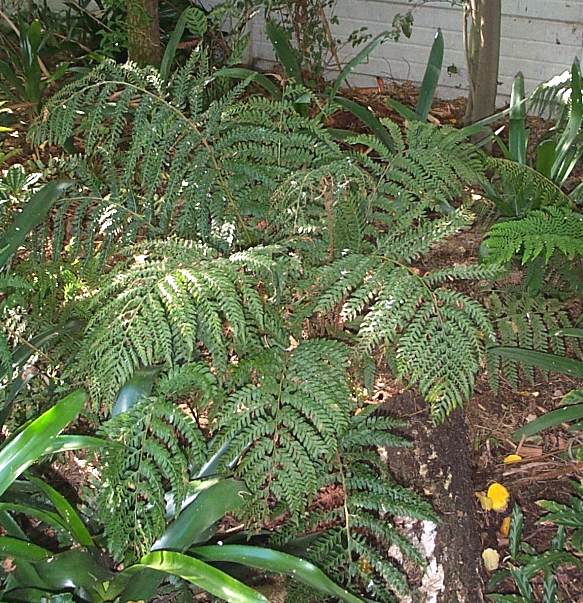
Polystichum incongruum: forest shield fern (Eng.); woud skildvaring (Afr.)
This species is confined to the Western and Eastern Cape in South Africa, occurring at elevations ranging between 600 and 1 350 m. Although it mostly occur in forests, it is not confined to them, often forming large stands on road cuttings. As a result of the decumbent and branched rhizome, the species has a shrub-like growth form, reaching a height of up to 0.8 m. The leathery dark green, erect to arching leaves may reach a length of up to 1.8 m, and can be up to 3 times divided. The species is best cultivated in moist, shaded conditions, although it will tolerate some sun once it is well established and the growing medium is kept adequately irrigated. Propagation is best done by rhizome division.
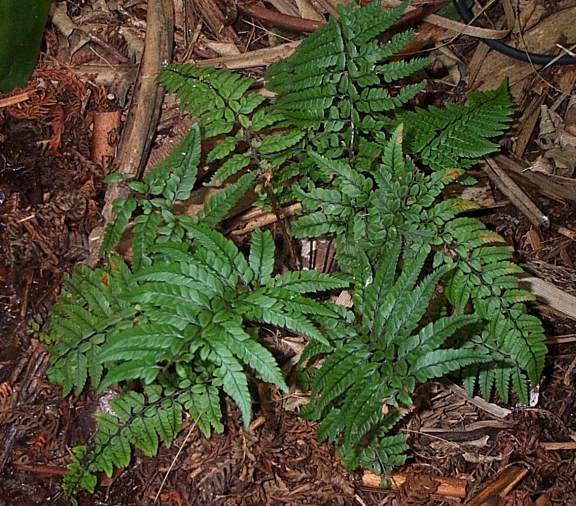
Polystichum luctuosum: mourning shield fern (Eng.); treur skildvaring (Afr.)
The species has a wide distribution in the Old World, extending as far as Japan. It is also widely distributed in South Africa, occurring from the Eastern Cape through KwaZulu-Natal to the north-eastern parts of the Free State, Mpumalanga and the Northern Province. It grows at elevations ranging between 760 and 1 740 m. The species is confined to evergreen forests where it grows on the forest floor or on rocks. P. luctuosum is often sold as P. tsus-simense and is a predominantly single-stemmed species resulting in a tussock-like growth. It can reach a height of up to 0.4 m. This smaller species has a very neat appearance, and is characterised by the almost black scales and dark veins, which contrast with the olive-green leaves. It is best cultivated in shade and needs to be kept moist, but not wet, at all times. It is a slow grower. Propagate by spores.
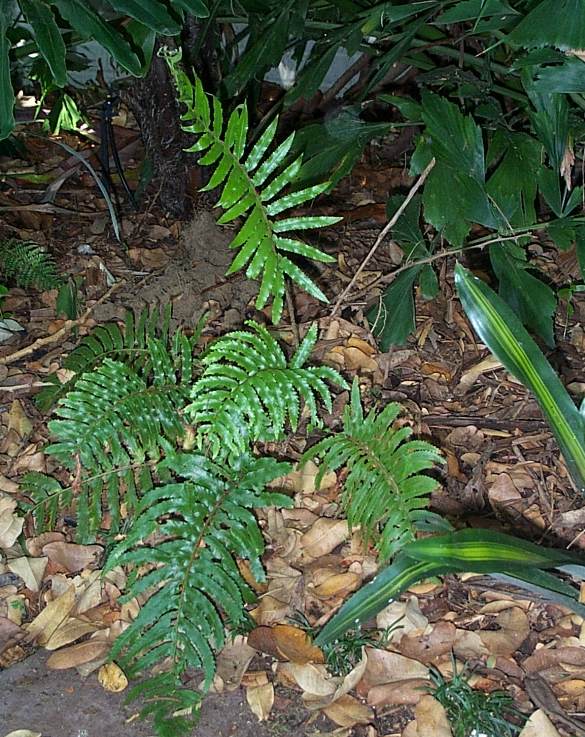
Polystichum macleae: McLea's shield fern (Eng.); oostelike skildvaring (Afr.)
Polystichum macleae is confined to the Drakensberg Escarpment and Wolkberg in Mpumalanga, occurring at elevations ranging between 1 350 and 1 960 m. It usually occurs in evergreen forests, but at higher elevations it is also found in the lee of large boulders. As a result of the decumbent, sparsely branched rhizome, it often forms small clonal stands resulting in a shrubby growth form. This is the only South African species with 1-pinnate leaves. They are mid- to dark green and can grow up to 1.5 m long. This very attractive species is worthy of cultivation. The species is best cultivated in light shade and requires permanently moist conditions. Propagate by rhizome division.
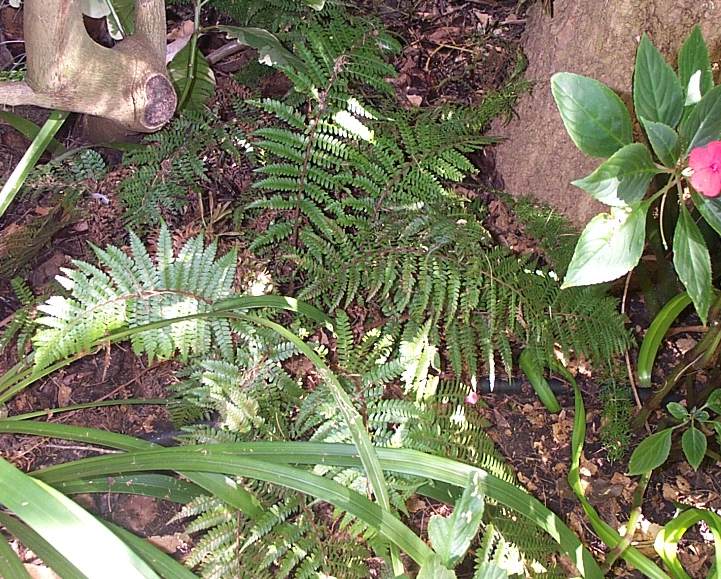
Polystichum monticola: mountain shieldfern (Eng.); berg skildvaring (Afr.)
Polystichum monticola is confined to South Africa, extending from the Kamiesberg in the Northern Cape, through the Western and Eastern Cape, KwaZulu-Natal and the Free State, to Lesotho, occurring from 600 to 2 740 m. The habitat includes seasonally moist, evergreen forests, rock crevices, cliff bases, stream banks, and forest margins, often growing in exposed, seasonally xeric conditions. The rhizome is decumbent and closely branched, resulting in plants forming a shrubby growth form. This variable and predominantly high altitude species is ideally suited for garden cultivation. The arching leaves are mid-green in colour and up to 0.8 m long. Although the species will tolerate some sun once well established, it is best cultivated in moist conditions in light shade. The species is slow-growing, and propagation is best done by rhizome division.

Polystichum pungens: forest shield fern (Eng.); woud skildvaring (Afr.)
Polystichum pungens is restricted to South Africa and Swaziland. In this region it ranges from Table Mountain, along the southern mountain ranges, and the Drakensberg foothills to the Wolkberg in Mpumalanga. It occurs at elevations ranging from 600 to 1 350 m and is restricted to forests. The rhizome is decumbent and regularly branched, resulting in the plants forming clonal stands and a shrubby growth form. The leathery leaves can be up to 1 m long, are dark green, and suberect to arching. The species is best cultivated in moist shaded conditions, but will tolerate morning sun once well established. Propagate by rhizome division.
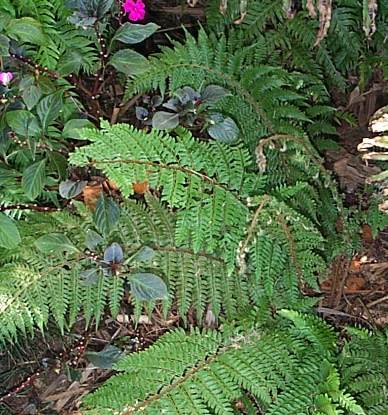
Polystichum transvaalense: stemmed shieldfern (Eng.); enkelstam skildvaring (Afr.)
Polystichum transvaalense is widely distributed in temperate and tropical Africa. In South Africa it occurs from the Drakensberg foothills in the Eastern Cape along the KwaZulu-Natal Drakensberg escarpment, the Eastern Cape and southern KwaZulu-Natal midlands, the Free State/KwaZulu-Natal and Mpumalanga/Limpopo Province escarpment to the Soutpansberg, with outlying populations in the southern Cape mountains. It occurs at altitudes ranging from 365 to 1 840 m and is confined to forests. It has a short, erect, usually unbranched rhizome and a tussock-like growth form. In suitable conditions the suberect to arching pale- to mid-green leaves may be up to 1 m long. The species is suited to be used as a focal point in smaller gardens and should best be cultivated in light shade, preferring moist conditions. The species is worthy of cultivation because of its neat appearance. Propagate from spores.
Plant Attributes:
Plant Type:
SA Distribution:
Soil type:
Flowering season:
PH:
Flower colour:
Aspect:
Gardening skill:
Special Features:
Horticultural zones
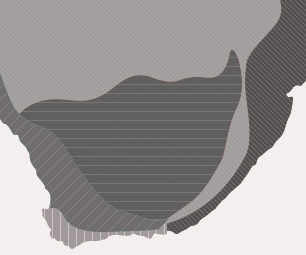
Family: Dryopteridaceae Class: Filicopsida Order: Polypodiales
Family:
Common names: wood fern family
Plant Attributes:
Plant Type:
SA Distribution:
Soil type:
Flowering season:
PH:
Flower colour:
Aspect:
Gardening skill:
Special Features:
Horticultural zones






Rate this article
Article well written and informative
Rate this plant
Is this an interesting plant?
Login to add your Comment
Back to topNot registered yet? Click here to register.